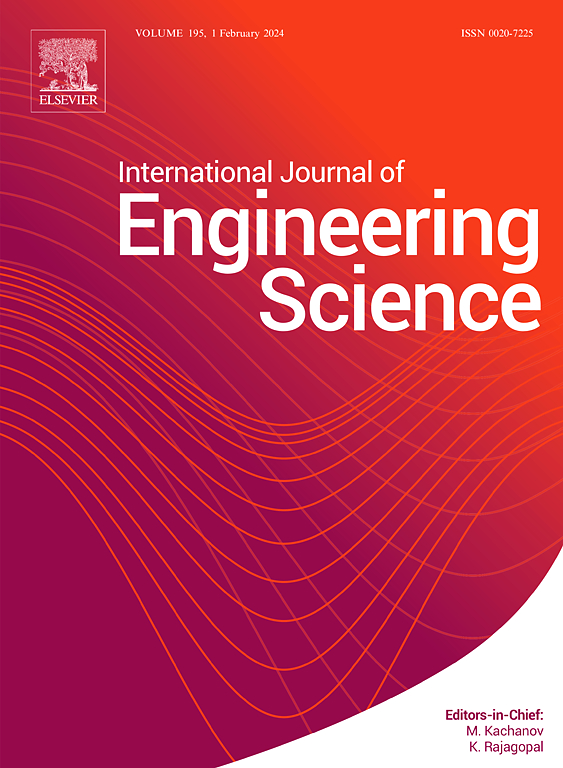Indentation of layered soft electroactive media
IF 5.7
1区 工程技术
Q1 ENGINEERING, MULTIDISCIPLINARY
International Journal of Engineering Science
Pub Date : 2025-03-29
DOI:10.1016/j.ijengsci.2025.104250
引用次数: 0
Abstract
Novel layered soft electroactive materials/structures have various special functions and features which can be uniquely applied to different modern science and engineering fields. In this paper, three-dimensional full-field solutions for the indentation characterization of layered soft electroactive media are presented by using a newly established semi-analytical approach. This approach is based on the integration of the Fourier-Bessel series system of vector functions, the dual-variable and position method and the Green's function. For illustration, the flat-ended indentation of a layered neo-Hookean ideal dielectric half-space, incorporating interfacial imperfections and material inhomogeneity between adjacent layers, is taken as an example. The present method is first verified by comparing with the exact solution for a reduced homogeneous case and then applied to multi-layered half-spaces with varying interfacial conditions, ranging from the frictionless contact case to the perfectly bonded case, and with linearly/exponentially graded shear moduli within the layers. The effects of the material compressibility and the interfacial imperfections on the full-field responses are investigated through one-layer and two-layer half-space models, respectively. The imperfections are found to play as barriers in the propagation of indentation-induced distortion within the layered structure. The comparison between the incremental von Mises stress for 20-layer and 100-layer half-spaces further highlights the positive significance of increasing layers to prevent stress mismatches in such structures. Most interestingly, with the advantage of much lower cost on fabrication, the layered structure with sufficient layers is quantitively demonstrated to achieve desired performance comparable to the continuously graded one. We believe that the present study not only establishes a good reference for characterizing the properties of soft multi-field coupled materials/structures containing material inhomogeneity and/or imperfections but also provides a benchmark pattern for addressing related complex boundary-value problems.
层状软电活性介质的压痕
新型层状软电活性材料/结构具有多种特殊的功能和特点,可以独特地应用于现代科学和工程的各个领域。本文采用一种新建立的半解析方法,给出了层状软电活性介质压痕表征的三维全场解。该方法基于向量函数的傅里叶-贝塞尔级数系统的积分、双变量和位置法以及格林函数。为了说明,以分层新胡克理想介质半空间的平端压痕为例,其中包含相邻层之间的界面缺陷和材料不均匀性。首先通过与简化均匀情况下的精确解进行比较来验证该方法,然后将其应用于具有不同界面条件的多层半空间,从无摩擦接触情况到完美结合情况,以及层内线性/指数梯度剪切模量。通过单层半空间模型和双层半空间模型分别研究了材料可压缩性和界面缺陷对全场响应的影响。发现缺陷在层状结构中作为压痕畸变传播的障碍。通过对20层和100层半空间的von Mises应力增量的比较,进一步强调了增加层数对防止此类结构应力错配的积极意义。最有趣的是,具有更低制造成本的优势,具有足够层数的层状结构被定量地证明可以达到与连续分级结构相当的预期性能。我们认为,本研究不仅为表征含有材料不均匀性和/或缺陷的软多场耦合材料/结构的性质提供了良好的参考,而且为解决相关的复杂边值问题提供了基准模式。
本文章由计算机程序翻译,如有差异,请以英文原文为准。
求助全文
约1分钟内获得全文
求助全文
来源期刊

International Journal of Engineering Science
工程技术-工程:综合
CiteScore
11.80
自引率
16.70%
发文量
86
审稿时长
45 days
期刊介绍:
The International Journal of Engineering Science is not limited to a specific aspect of science and engineering but is instead devoted to a wide range of subfields in the engineering sciences. While it encourages a broad spectrum of contribution in the engineering sciences, its core interest lies in issues concerning material modeling and response. Articles of interdisciplinary nature are particularly welcome.
The primary goal of the new editors is to maintain high quality of publications. There will be a commitment to expediting the time taken for the publication of the papers. The articles that are sent for reviews will have names of the authors deleted with a view towards enhancing the objectivity and fairness of the review process.
Articles that are devoted to the purely mathematical aspects without a discussion of the physical implications of the results or the consideration of specific examples are discouraged. Articles concerning material science should not be limited merely to a description and recording of observations but should contain theoretical or quantitative discussion of the results.
 求助内容:
求助内容: 应助结果提醒方式:
应助结果提醒方式:


